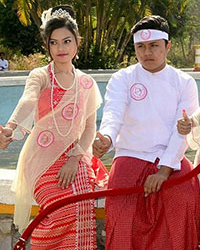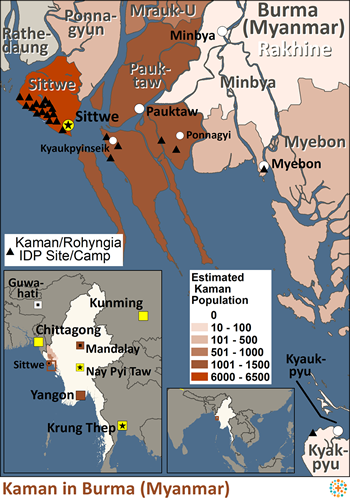After being counted separately in the 1931 census, for almost a century the Kaman have been formally recognized by the government and classified as one of the seven ethnic groups composing the Rakhine race. Consequently, they have enjoyed the rare distinction of being a Muslim group in Myanmar holding national identity cards as fully-fledged citizens.
Location: More than 50,000 Kaman people inhabit the three districts of Kyaukpyu, Sittwe, and Thandwe in southwest Myanmar's Rakhine State, while thousands more have moved to Myanmar's largest city, Yangon, in recent years. The main concentration of Kaman dwell on Ramree Island (Yanbye in Burmese), the largest island in Myanmar, which is separated from the mainland by a narrow strait only 490 feet (150 meters) wide. Kaman territory sits on the Bay of Bengal and is subject to the same violent cyclones that annually devastate adjacent areas of Bangladesh and West Bengal, India. The genocidal chaos, slaughter and rape that engulfed Rakhine State in recent years has resulted in many Kaman families moving to Yangon to avoid the violence, while there are also many Kaman people among the hundreds of thousands of Muslims who fled Myanmar and are now crammed into refugee camps in nearby Bangladesh.
Language: Although the Kaman are a distinct people group with a unique identity and history, there is no evidence that they ever had their own language. They adopted Rakhine after arriving in the area and have spoken it ever since.
The Kaman are believed to be descended from Persian, Afghan and Mughal noblemen who settled on Ramree Island many centuries ago. Their name comes from a Persian word for “bow,” reflecting their role as archers when they were brought to serve in the armies of the Kingdom of Mrauk U, which flourished from 1429 to 1785. At the height of its power, Mrauk U “was home to a multi-ethnic population with mosques, temples, shrines, seminaries and libraries. The kingdom was also a center of piracy and slave trade frequented by Arab, Danish, Dutch, and Portuguese traders. In 1945, over 1,000 Japanese soldiers launched an offensive on Ramree during the Second World War. Many parachuted into the island's mangrove swamps only to be devoured by saltwater crocodiles. The carnage was so great that some reports said only 20 of the more than 1,000 troops survived the ordeal.
Since 2012, militant Burmese Buddhists have stirred up conflict with Muslim groups like the Kaman. The government stopped distributing citizenship cards to the Kaman and moved many of them into refugee camps alongside the Rohingya. Kaman homes were burned and their businesses looted. Many fled to Yangon and other cities to avoid the violence but have struggled in their new surroundings as the government seized their land in Rakhine State. Those who remained in the Kaman homeland have faced dire times. In 2024, Kaman men between the ages of 18 and 55 were ordered to join the Burmese military or they would have their citizenship revoked. At the same time, the Kaman were pressured to fight for the Rakhine Amy against the junta.
The Kaman converted to Islam over six centuries ago, but they hold a unique position in Myanmar in that they are devoted Muslims who are culturally Buddhist and observe Rakhine customs. Their genetic heritage gives them a markedly different appearance from the Rakhine and other groups in the state.
Although the first church was planted on Ramree Island nearly two centuries ago by the American Baptist missionary Lyman Stilson in May 1829, the Kaman remain one of the most unreached people groups in Myanmar. Islam shapes their ethnic identity, so it has proven difficult for the Gospel to make inroads into their tight-knit communities after more than a century of sporadic efforts to reach them. There may be a small number of Kaman Christians today, although none are confirmed. If there are any, they likely keep a very low profile to avoid being ostracized by the other Kaman.
Scripture Prayers for the Kaman in Myanmar (Burma).
| Profile Source: Asia Harvest Copyrighted © Used with permission |

























